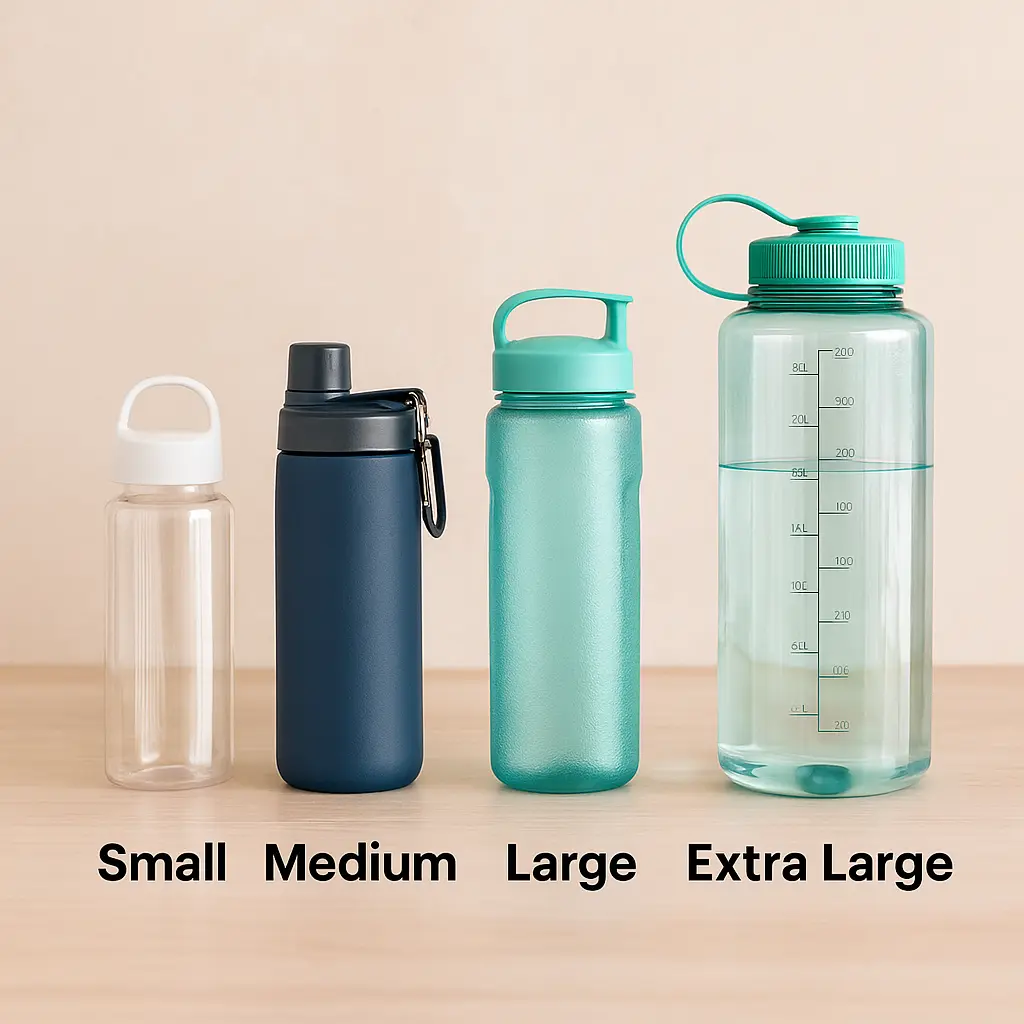Majoritatea adulților au nevoie de aproximativ 2700–3700 ml pe zi.
One-step gift customization and wholesale — customize any product you need with ease and efficiency!
Apa îmbuteliată variază de obicei între 250 ml și 2.000 ml, fiecare dimensiune deservind nevoi diferite - de la hidratare rapidă din mers până la activități în aer liber pe tot parcursul zilei. Cunoașterea capacității exacte vă ajută să planificați mai precis aportul de lichide, să adaptați dimensiunea sticlei la stilul dvs. de viață și să mențineți o hidratare adecvată fără a consuma prea mult sau prea puțin.
Cuprins
Înțelegerea expresiei „ml” în sticlele de apă
Când discutăm despre câți ml există într-o sticlă de apă, este important să înțelegem ce înseamnă „ml”. Mililitrul (ml) este o unitate de măsură pentru volumul unui lichid, iar 1 ml este egal cu 1/1.000 dintr-un litru.
Conversii comune:
1.000 ml = 1 litru (L)
500 ml ≈ 16,9 uncii fluide (fl oz)
De ce contează acest lucru:
Te ajută să urmărești cu exactitate aportul zilnic de apă.
Facilitează alegerea capacității potrivite pentru stilul tău de viață.
Deosebit de important pentru sportivi, excursioniști și oricine trebuie să calculeze cu precizie nivelurile de hidratare.
Înțelegând expresia „ml”, poți determina rapid câți ml conțin o sticlă de apă și îi poți adapta nevoilor tale zilnice.
Dimensiuni comune ale sticlelor și capacitatea lor în ml
Când te uiți la câți ml există într-o sticlă de apă, acestea sunt cele mai comune dimensiuni pe care le vei găsi și cum sunt utilizate de obicei:
| Dimensiunea sticlei | Capacitate ml | Caz de utilizare comun |
|---|---|---|
| Mic | 250–330 ml | Pentru copii, călătorii scurte sau ca rezervă într-o geantă de mână |
| Mediu | 500 ml | Perfect pentru uz la birou sau pentru transport zilnic |
| Mare | 750–1000 ml | Ideal pentru antrenamente sau perioade lungi de timp în aer liber |
| Extra mare | 1500–2000 ml | Ideal pentru drumeții, camping sau călătorii pe distanțe lungi |
Cunoașterea acestor categorii face mai ușoară alegerea dimensiunii potrivite atunci când decideți câți ml dintr-o sticlă de apă se potrivesc nevoilor dumneavoastră.
Cum să alegi dimensiunea potrivită a sticlei

Alegerea dimensiunii potrivite a sticlei de apă începe cu înțelegerea numărului de ml dintr-o sticlă de apă și potrivindu-l cu obiectivele tale zilnice de hidratareMajoritatea adulților au nevoie de aproximativ 2,7–3,7 litri de apă pe zi, ceea ce se traduce în:
Șase sticle de 500 ml pentru un aport zilnic echilibrat.
Patru sticle de 750 ml pentru mai puține reumpleri și hidratare constantă.
Două sticle de 1,5 l atunci când transporti apă pentru o zi întreagă în aer liber.
Nivelul de activitate și mediul înconjurător îți vor influența alegerea:
Utilizare la birou sau în studiu – O sticlă de 500 ml este ușoară, încape ușor într-o geantă sau într-un suport pentru pahare și încurajează reumplerea regulată pentru a menține apa proaspătă.
Sport sau sesiuni de sală – sticlele de 750 ml până la 1 litru sunt ideale, reducând întreruperile în timpul antrenamentelor.
Drumeții sau camping – sticlele de 1,5 l până la 2 l reduc la minimum opririle de reumplere și asigură o aprovizionare adecvată atunci când sursele de apă sunt limitate.
Rețineți că sticlele mai mari conțin mai multă apă, dar adaugă și greutate - 1,5 litri de apă cântăresc aproximativ 1,5 kg. Dacă portabilitatea contează, luați în considerare utilizarea a două sticle medii în loc de una extra-mare pentru un confort și o comoditate sporite.
Cum să verificați capacitatea în ml a sticlei dvs.
Verificați partea de jos sau eticheta – Majoritatea producătorilor imprimă capacitatea pe baza sau pe lateralul sticlei.
Folosește o cană gradată – Umple sticla cu apă folosind o cană marcată în mililitri pentru a determina capacitatea.
Cântăriți sticla – Umpleți sticla complet și cântăriți-o; deoarece 1 ml de apă ≈ 1 gram, greutatea este egală cu capacitatea în ml.
Tabel de conversie de la ml la alte unități – Câți ml sunt într-o sticlă de apă
Înțelegerea numărului de ml dintr-o sticlă de apă poate fi mai ușoară dacă cunoașteți conversiile de bază între mililitri, litri și uncii fluide americane. Folosiți acest tabel pentru a compara rapid capacitățile:
| ml | Litri | Uncii fluide americane |
|---|---|---|
| 250 ml | 0,25 litri | 8,45 uncii |
| 500 ml | 0,5 litri | 16,9 uncii |
| 1000 ml | 1 litru | 33,8 uncii |
| 2000 ml | 2 litri | 67,6 uncii |
Acest lucru te ajută să urmărești hidratarea zilnică și să alegi dimensiunea potrivită a sticlei în funcție de sistemul tău de măsurare preferat.
De ce cunoașterea ml te ajută să rămâi hidratat
Monitorizarea precisă a hidratării – Cunoașterea numărului de ml dintr-o sticlă de apă vă permite să măsurați cu precizie aportul, ajutând la prevenirea atât a deshidratării, cât și a suprahidratării.
Aportul de apă bazat pe dovezi științifice – Necesarul zilnic de apă în ml se modifică în funcție de nivelul de activitate, climă și dietă; înțelegerea capacității sticlei vă permite să vă ajustați cu ușurință.
Ecologic și rentabil – Alegerea dimensiunii potrivite a sticlei reutilizabile reduce risipa de unică folosință și economisește bani la reumplerile frecvente sau la achiziționarea de apă îmbuteliată.
Gânduri finale despre originea sticlei Owala
Deși mulți oameni se întreabă unde sunt fabricate sticlele de apă Owala, răspunsul este doar o parte a poveștii. Calitatea produsului depinde mult mai mult de standardele de fabricație, siguranța materialelor și gestionarea lanțului de aprovizionare decât de țara de origine.
Pentru cumpărătorii en-gros, cea mai sigură alegere este să colaboreze cu furnizori care au experiență dovedită în export, dețin certificări internaționale și pot oferi detalii clare despre producție - asigurându-se că comenzile dumneavoastră îndeplinesc atât cerințele de reglementare, cât și așteptările clienților.
Întrebări frecvente – Întrebări conexe despre câți ml de apă există într-o sticlă
1. Sunt suficienți 500 ml pentru un antrenament?
Suficient pentru antrenamente scurte, dar sesiunile mai lungi necesită mai multă apă.
2. Câți ml sunt într-o sticlă reutilizabilă standard?
Dimensiunile uzuale sunt 500 ml, 750 ml și 1000 ml.
3. Pot varia ml pentru aceeași dimensiune etichetată?
Da, din cauza diferențelor de formă a sticlei, grosimii peretelui și materialelor.
4. Câți ml ar trebui să beau zilnic?
Introducere
Suntem o ghișeu unic cadou personalizat companie, oferind servicii de design, personalizare personalizată, ambalare elegantă și livrare pentru a vă ajuta să îmbunătățiți prezența mărcii și să consolidați relațiile cu clienții.
©2025. yourgiftstory Toate drepturile rezervate.

